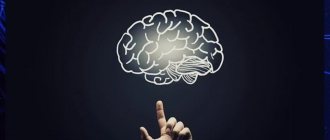In a narrow sense, consciousness is considered as the highest form of the psyche, and the psyche itself is considered as the level of the unconscious. Unconscious processes are not realized by the person himself. The area of the unconscious includes various phenomena, for example, dreams, responses, unconscious behavior, etc.
Psychology explains the emergence of human consciousness by the social way of being of people and work activity.
Information entering the brain, in the process of displaying reality, is consciously processed according to the goals, objectives, and experience of the individual. Depending on the level of knowledge of the individual, scientific worldview, ideological and moral beliefs, the level of development of consciousness among people is different.
Consciousness has its characteristic features and structural components.
Feeling is the initial experience of the analyzers, communication. with sensory organs and stimuli.
Types: vision, hearing, smell, muscle, tactile, pain, etc.
Thresholds: Absolute threshold - the magnitude of the stimulus, at the beginning. sensation (upper and lower)
Differential - at the beginning. discrimination
Psychometric function is the dependence of the probability of detecting stimuli on their intensity.
7 pages, 3023 words
Feelings 2
… . Sensation is a cognitive process in which, as a result of the direct impact of stimuli on the sense organs, the individual properties of objects in the objective world are reflected. Sensation is a reflection of individual..., sound of objects and phenomena. Sensations provide material for other, more complex mental processes - perception, thinking, imagination. Sensations are also common to animals. (Examples In...
Influenced by: the training of the analyzer, fatigue, installation, the nature of the stimulus, the “cost of error,” adaptation (glasses on the forehead)
Properties of consciousness
There are several basic psychological properties in the human mind:
- Consciousness is characterized by activity. In the process of practical, transformative activity, a person reflects the external world, therefore consciousness is also characterized as a spiritual activity aimed at an active, creative transformation of reality. The activity of consciousness will also be characteristic of social consciousness, for example, progressive ideas that, having mastered the masses, become “material force”;
- Intentionality of the subject's consciousness. In other words, this is a focus on any object, not necessarily on the object of the material world or any specific object. This may be the awareness of some fact, thought at the moment of communication with another subject;
- Consciousness is characterized by constant reflection or a process of continuous introspection in the subject;
- Motivational-value nature of consciousness. This means that a real subject always strives for some goal, even if the goal is the absence of a goal;
- Integrity of consciousness. The general holistic consciousness includes the unconscious, subconscious, conscious, superconscious. All these components are inextricably linked and simultaneously manifest themselves to varying degrees, which depends on the specific mental activity;
- The generalization and abstraction of consciousness manifests itself when it operates with non-real objects and phenomena of the surrounding world;
- Selectivity of consciousness or its focus only on a specific object, and not on the whole world as a whole;
- The dynamism of consciousness or its changeability and ability for continuous development;
- Distortion of consciousness, which manifests itself in the fact that consciousness always reflects reality in a distorted form;
- The uniqueness and individuality of consciousness lies in the fact that the consciousness of each individual person is different from the consciousness of other people.
Consciousness arises only in real, living, thinking subjects and belongs to the realm of the ideal, because images, sensations, and meanings cannot be considered as material objects.
Thinking: types and processes. Intelligence.
M is the highest form of indirect reflection. Reveals the essence. Understanding processes.
Thinking is the highest level of human cognition, a process of reflection in the brain of the surrounding real world, based on two fundamentally different psychophysiological mechanisms: the formation and continuous replenishment of the stock of concepts, ideas and the derivation of new judgments and conclusions.
5 pages, 2117 words
CONCEPT OF PERCEPTION. PROPERTIES, TYPES OF VISUAL PERCEPTION.
... STRUCTURALITY AND DETAIL are determined by the ability to use knowledge of the general properties of a class of objects in the process of perceiving one of them. CONSTANTITY - the relative constancy of perceived... accumulation of sensory experience, development of observation, improvement of examination skills, activation of thinking. memory images undergo constant changes, which can occur as ...
Types of thinking
There are several types of thinking. First of all, in accordance with genesis - visual-actual, visual-imaginative, visual-schematic and verbal-logical. There is also a special type of thinking - pre-logical, characteristic of traditional societies. The basis for distinguishing types of thinking are also: their orientation (practical and theoretical, realistic and autistic), features of the thought process (logical and intuitive, convergent and divergent) and the result (reproductive and creative).
Let's analyze each of the listed types of thinking in detail.
Prelogical thinking is one of the earliest stages in the development of thought and is characteristic of primitive cultures. This type of thinking was first described by L. Lévy-Brul, who showed that, unlike logical thinking, it is carried out with other forms and operations, namely magic, faith in the living world, worldly experience embodied in language and tools . In this process, the essence of objects and phenomena is often mystified, and they themselves are correlated according to the criteria of “cause and effect” and coincidence in time and space. L. Lévy-Brul believed that echoes of this kind of thinking are still manifested in everyday consciousness, for example, in superstitions, fears, religion, belief in psychics and magicians, in ways of solving certain everyday situations.
The study of the genesis of thought has shown that the first ontogeny and, apparently, phylogeny (with the exception of proto-logical) is visually actual thought, sometimes called “manual intelligence.” This type of thinking is characterized by solving a problem using a real, physical implementation of the situation, checking the properties of objects, since the subject needs direct interaction with the objects contained in the problem situation. So the rat has to run through the maze before it can figure out how to get the meat and water. The child must throw various objects into a bowl of water several times before he can determine which one floats and which one sinks. This type of decision has been studied by behaviorists and is called trial and error.
The next type of thinking is figurative thinking, in which the subject most fully recreates the variety of various actual properties of objects and situations without any real contact with them, based only on the representation of these objects and situations and the changes occurring in them. An important aspect of visual imaginary thinking is that in a picture you can see an object from several points of view simultaneously, i.e. the cognitive egocentrism characteristic of solving problems using visual-realistic thinking is overcome.
Having accumulated sufficient experience in solving problems based on orientation in the real world, in terms of behavior, and recognizing the causes of errors, the subject can imagine the pattern and result of an action even before it begins, based on orientation in the image of the situation. Thus, children (and, apparently, primitive people) move on to the next stage of thinking, obtaining the correct answer based on sensory (mostly visual) analysis of the situation, without direct contact with objects.
Thus, we can say that the differences between different types of thinking are associated with differences in orientation - either in orientation in action parallel to the decision (visual-actual thinking), or in orientation at the internal, imaginative level preceding the decision (visual-imaginary thinking). .
The importance of studying psychology for nurses
The nurse is the main assistant to the doctor, carrying out his appointments
But not only the success of treating the disease depends on her work, but also the mood and mental state of the patient, which is also of no small importance for the treatment of the disease and the timing of final recovery.
The main causes of conflicts that arise in medical institutions are ignorance of medical psychology, inability to understand the psychology of the patient
, his relatives.
The nurse needs to study and know
- the psychology of their patients,
- their attitude towards their disease and treatment methods,
- characteristics and character traits of their patients,
- emotions and much more.
The disease is always individual, it affects a specific person, and in order to find the means to heal it, the physician must imagine not only the external, but also the internal picture of the disease, see the possible psychological prerequisites and consequences of pathological processes, and understand the patient’s personality changed by the disease. Analysis of complaints and medical history, somatic and psychiatric examinations, conducting all types of examinations. Prescribing and implementing etiological and pathogenetic differentiated therapy, resolving issues for those recovering - all this requires the medical worker to know the patient’s personality.
5 pages, 2321 words
Features and structural components of consciousness
Consciousness as the highest form of mental reflection of reality has its own characteristics and structural components:
- Knowledge about nature, society and the surrounding reality in general. The knowledge and experience of an individual, the level of their assimilation are directly related to the level of consciousness. The need for knowledge developed during the entire socio-historical development of people and was the motive for cognitive activity;
- Distinguishing between the subject “I” and the object “I”, identifying oneself as a subject of cognition in the objective world. In relation to contrasting oneself as a person with another objective world, self-knowledge is. It has become the basis for self-awareness or awareness of one’s own physical, moral and psychological qualities;
- This side of consciousness as determination, planning one’s activities and behavior, guessing results, manifests itself in self-control and adjustment of one’s own actions, if necessary;
- The individual’s attitude towards himself, the people around him, and objective reality is manifested in assessment and self-criticism, where the emotional-volitional sphere of the personality plays an important role.
A person becomes a subject of education thanks to consciousness, self-knowledge and self-awareness; only in this case does he set educational goals for himself and achieve the results he needs.
A person's self-awareness manifests itself:
- In self-observation;
- In a critical attitude towards oneself;
- In assessing both your positive and negative qualities;
- In self-control;
- Responsible for actions taken.
Consciousness and activity of the individual always appear in unity, which is manifested in the purposeful activity of a person, in a variety of cognitive, emotional, volitional reactions, attitudes towards other people and oneself.
An important advantage of consciousness is that it relies on speech, thanks to which (external and internal) consciousness is capable of organizing complex activities. A person and his environment interact as an integral organism, which is ensured by the cerebral cortex.
Different status.
—
The disadvantage is that a person, if desired, can consciously
influence the results obtained, especially if he knows in advance how the test is structured and how his psychological characteristics will be assessed based on its results.
In these cases, projective techniques are usually used:
· projective,
which can be used to study processes that are not conscious to humans.
- “Draw a family”
- “House-tree-man”,
- “Draw a non-existent animal,” etc.
— The Luscher test is widely used,
- Rorschach test (inkblot test), etc.
The following research methods are used:
I.
Observation
is a method of collecting primary information about the object under study through direct perception and direct recording of facts that are significant for the purposes of the study.
There are several types
observations
About internal surveillance
we talked above.
1. External surveillance
- This is an observation from the outside.
2. Free observation
does not have a pre-established framework and program,
3. a standardized
, on the contrary, is predetermined and is carried out according to a clear program.
4. Participant observation
involves the psychologist’s personal participation in the study when he turns into a homeless person, a religious fan, a drug addict, etc.
5. You can also observe a person unnoticed.
Under covert surveillance
, which is often used in relation to preschool children, you can use a tape recorder, a video camera, or a Gesell mirror (glass that is transparent only from the observer’s side).
Observation is widespread in many sciences, including medicine, and has advantages
and
cons
.
— Observation is carried out in natural conditions
. +
+ —
- Its relative simplicity
combined with
the subjectivity of the observer
and certain
difficulties in preparing data for processing.
— — Observation allows you to record events and elements of human behavior at the moment of their occurrence.
II.
Experiment
- one of the main methods of psychology.
This is a method that involves the active intervention of the researcher in the activities of the experiment participant in order to create conditions for testing a hypothesis.
An experiment in psychology always involves the participation of people, which creates additional moral and ethical problems:
1. Firstly, people can only be experimented on with their consent.
2. Secondly, experiments that can cause harm should not be performed at all.
3. Thirdly, the progress and results of the experiment significantly depend on:
- how the goal is understood by the participants,
- where, when and by whom the experiment is carried out,
- how the experimenter behaves, etc.
Organizing and conducting a real psychological experiment that meets all the requirements in practice can be difficult.
In this regard, it is used much less frequently than other methods.
The experiment could be:
— laboratory
when it takes place in specially organized conditions, and the actions of the participants are determined by instructions;
— natural
when the study is carried out in natural conditions (for example, the development of deaf-blind children);
— stating
when psychological phenomena are studied;
— formative,
if in its process certain psychological qualities of the experiment participants develop.
For example: T.V. Endovitskaya studied visual acuity in preschool children using Landolt rings in two series of experiments. First, they measured at what distance the children were able to detect a gap in the ring under normal conditions, then they offered them a game of “hunting.” On average, visual acuity for all participants increased by almost 30%.
Methods of modern psychology
1. Organizational methods.
2. Empirical methods.
3. Data processing and interpretation methods.
4. Correction methods.
Organizational methods.
Psychology, like any science, uses a whole system of private methods or techniques. Methods of psychology are ways of finding out the facts that characterize the nature and patterns of mental life.
In Russian psychology, the following four groups of methods are distinguished (according to B.G. Ananyev):
1) Organizational methods.
2) Empirical methods.
3) Data processing methods.
4) Interpretive methods.
Correction methods (methods of psychological influence) are included in a separate group.
Organizational methods include:
1) Comparative method or cross-sectional method (this is a comparison of different groups of subjects by age, activity, etc.). Advantage: obtaining results within a short time. Disadvantage: this method makes it possible to determine purely external changes in development and obtain average values common to all.
2) Longitudinal method or longitudinal section method (multiple examinations of the same individuals over a long period of time). Advantages: allows you to identify patterns of mental development during the transition from one age stage to another, to identify important formations that appear at the end of each stage. Disadvantage: significant time consumption.
3) Complex method (representatives of various sciences participate in the study, i.e. one object is studied by different means). For example, the “Children of Chernobyl” program.
Empirical methods.
The group of empirical methods is considered the main one and includes the following methods:
1) Observation and introspection.
2) Experimental methods.
3) Psychodiagnostic methods.
4) Analysis of activity products.
5) Biographical methods.
Observation is one of the simplest and most common methods in psychology. It consists in the deliberate and purposeful perception of mental phenomena in order to study their specific changes in certain conditions and find the meaning of these phenomena, which is not directly given. Observation is usually carried out in natural conditions, without interfering with the course of activity. Actions and words are recorded in detail and then analyzed. Scientific observation is characterized not by simple recording of a fact, but by the transition from its description to explanation. Such monitoring requires a clear plan.
Scientific observation is directly in contact with ordinary everyday observation. Therefore, it is necessary to clearly distinguish them.
Scientific observation has a number of important requirements that everyday observation does not have:
1. Definition of a clear goal and objectives (why observe?).
2. Selecting an object, subject and situation (what to observe?).
3. Choosing an observation method that has the least impact on the object under study and most ensures the collection of the necessary information (how to observe?).
4. Selecting methods for recording what is observed (how to keep records?).
5. Processing and interpretation of the information received (what is the result?).
There are two types of observations: scientific-psychological (requires special training and scientific knowledge) and psychological-pedagogical (for example, the study of the cognitive, intellectual spheres of schoolchildren).
The main advantage of the method is that it allows you to study mental processes in natural conditions. However, disadvantages should also be highlighted: the results of observation can be significantly influenced by the personal characteristics of the observer; also, long-term observation leads to fatigue, adaptation to the situation, which also increases the danger of inaccurate recordings; in addition, this method requires a significant investment of time. Therefore, observation is used primarily when minimal intervention by the researcher in the behavior of the subject is required.
One form of observation is introspection .
The experimental method is a research activity that has the following requirements that are different from the requirements for the observational method:
1. The researcher himself creates the conditions in order to cause the phenomenon being studied and actively influences it, i.e. actively interferes with the subject's activities.
2. The experimenter can change the conditions under which the phenomenon occurs.
3. To test, the researcher may repeat his methods.
There are laboratory and natural experiments. A laboratory experiment takes place in laboratory conditions using special equipment, the actions of the subject are determined by instructions, the subject knows that they are experimenting on him. The last condition can sometimes disrupt the natural flow of mental phenomena. A natural experiment does not have this drawback (the term was introduced by A.F. Lazursky in 1910): the study is carried out under normal natural conditions (for example, during a lesson) and, thus, the tension in the subject that arises during a laboratory experiment is eliminated.
There are two types of natural experiment: ascertaining (a phenomenon is studied, conclusions are drawn about the presence/absence of a certain feature, the sum of features, features) and formative (serves at the same time as a means of research and a means of shaping the phenomenon being studied, i.e. such conditions are created that in which the subjects develop the desired mental qualities (for example, a culture of communication)).
Psychodiagnostic methods include tests, questionnaires, questionnaires, interviews, conversation, sociometry.
Test translated from English means “test”, “test”. The term was introduced into practice at the end of the last century by the American scientist J. Cattell, and tests have become widespread since A. Binet and T. Simon developed a special system to determine the mental development or giftedness of children. A test is a short-term task with the help of which a psychologist seeks to establish certain psychological qualities of an individual. In some cases, in order to obtain correct information about the subject, it is desirable to combine the test method with other psychological methods, because the fact of solving or not solving a test does not yet determine the internal causes of the phenomenon being studied.
The purpose of another psychodiagnostic method, the survey method, is to obtain information from the words of the respondents.
There are two types of surveys:
1) “Face to face” - interview. Here the researcher asks questions directly and according to a specific plan. Advantage: ability to vary questions. Disadvantages: due to the lack of anonymity, there may be dishonest answers, allows you to reach a small number of people.
2) Correspondence survey - questionnaires intended for self-completion.
When compiling questionnaires, the following requirements are taken into account:
- each question must be logically separate,
- questions should not be too long,
- each question must be specific,
- questions should be formulated in such a way as to avoid template answers,
- questions should not be suggestive (“don’t you agree?”),
- questions relating to events and facts are posed first, then more complex questions that require assessment, and at the end - simple ones,
— for the reliability of data, not only direct, but also indirect questions, as well as control questions (lie detectors), can be used.
Advantages: the possibility of mass coverage of a large number of people in a short period of time, the questionnaire guarantees anonymity and therefore the sincerity of the answers, ease of processing, conducting questionnaires does not require qualifications.
All survey methods have some limitations. These methods are based on self-observation of the respondents, so even if the subjects answer sincerely, these answers may be purely subjective and therefore not always correct.
The main condition of the conversation method is mutual understanding between the researcher and the subject, which takes place in informal conditions. It is built according to a specific plan, but does not boil down to simply asking questions; it should not be of a formulaic nature; tasks and questions should be as natural as possible. This is more of a confidential conversation. It is advisable to combine this method with other objective methods.
Another psychodiagnostic method is the analysis of activity products. This method is widely used in historical psychology to study human psychology in long-past historical times that are inaccessible to direct observation. The method is also widely used in child psychology, where children's creative products are studied for the psychological study of the child.
The biographical method is a type of method for studying the products of activity. The materials used here are letters, diaries, biographies, and handwriting.
Data processing and interpretation methods.
Data processing methods include a quantitative method (statistical) and a qualitative method (analysis of results, identification of new facts, differentiation of material into groups).
Interpretive methods are represented by the following methods: genetic (analysis of material in terms of development, highlighting individual phases, stages, critical moments, etc.) and structural (establishes structural connections between all personality characteristics) methods.
Correction methods.
When choosing effective methods of influencing an individual or group, it is important to always be guided by one of the main principles of psychological practice - “Do no harm!”
In many cases, people need non-medical help (for example, acute dissatisfaction with themselves, others, life in general). The nature of such trouble lies not in the painful processes occurring in the body, but in the characteristics of his personality or life situation. Such people are not sick, but still need help. For this purpose, a set of techniques, programs and methods of influencing people’s behavior has been created, which are called correction methods. These include: training, discussion, method of presenting models, and other methods of therapeutic influence.
Training is a method of influence aimed at creating new mental formations or developing existing ones.
Three types of training:
- functional (development of basic mental functions and processes - memory, attention, thinking, will);
— auto-training (formation and development of mental self-regulation and relaxation skills);
— socio-psychological training (communication training, self-confidence training, socio-psychological sensitivity training, etc.).
During the training, various exercises, role-playing games, psycho-gymnastics are used, and group members provide feedback to each other.
The origin of the autogenic training method is associated with the name German. psychotherapist I.G. Schultz. These workouts include three components:
a) the ability to completely relax the muscles of the body and control the correct breathing rhythm,
b) the use of sensory images (visual, auditory, tactile) and pleasant ideas,
c) the use of words not only out loud, but also mentally (in the form of self-orders, self-pronunciation).
The method is used for the treatment and prevention of neuroses and functional disorders in the body, for emotional relief, allows a person to control himself in extreme conditions, etc.
Group (socio-psychological) training is a unique form of teaching knowledge and individual skills in the field of communication, as well as forms of appropriate correction. Group trainings can be recorded on tape or videotape, and then the group gives the analysis again. This form of training is called video training.
Trainings are widely used for training specialists and managers, as well as for resolving conflicts between parents and children, married couples, etc.
The method of presenting models is based on the use of mechanisms of mental infection, suggestion and imitation. The method has two levels of application: personal example of a manager/specialist, presentation of other people’s behavior as models. The second version of the method also involves the use of various movie characters, works of fiction, fairy tales, parables, anecdotes, etc.
Thanks to their imagery and emotional richness, they act as quite strong means of influence. Emotional contagion is a process based on the unconscious transfer from subject to subject of various kinds of mental states - excitement, joy, anxiety, inspiration, ecstasy, courage, which are unconsciously reproduced in situations of interaction. Based on emotional contagion, as a rule, imitation occurs, copying the behavioral acts and actions of another person. Copying is also based on the mechanism of identification, when a person wants to be like someone who is authoritative for him.
One’s own identity (self-awareness) is most actively built during adolescence and adolescence, and in a developing personality this process continues throughout the entire life course. Suggestion is an influence on the human psyche that involves an uncritical perception of the features of information. Suggestion is carried out both through verbal and non-verbal means. The peculiarity of suggestion is that it is addressed not to the logic and reason of the individual, but to his readiness to internally accept the transmitted information and indicated actions. A person’s suggestibility depends on the level of development of his consciousness and self-awareness.
Discussion is a discussion of an issue in order to find the optimal solution. There are certain rules for conducting effective discussions (speaking in turns without interrupting each other, clarifying the meaning of what the interlocutor said, giving each participant in the discussion the opportunity to speak, periodically summarizing what was said in the group). The predominant mechanism of influence here is persuasion - the process of influencing the judgments of the interlocutor by the power of logical evidence. The basic rules for the effective use of persuasion are: a sincere desire to understand the interlocutor, demonstration of one’s understanding to the interlocutor, respect for his personality, logic in constructing one’s arguments.
Notes
- Lectures on general psychology by V. V. Petukhov
- ↑. www.psychologos.ru. Retrieved May 23, 2021.
- Crick F., Koch C. The problem of consciousness // Scientific American. Special edition. 2002. Vol. 12. No. 1. R. 11-17
- ↑
- Atkinson R. Management of short-term memory. In the book: Psychology of Memory / Ed. Yu. B. Gippenreiter, V. Ya. Romanova. −3rd ed., revised. and additional - M.:AST:Astrel, 2008. - 656 p. - (Anthology on psychology). - 379-407 p.
- ↑ T. Nørretranders, The User Illusion: Cutting Consciousness Down to Size (New York: Viking, 1998); T. D. Wilson, Strangers to Ourselves: Discovering the Adaptive Unconscious (Cambridge, MA: Harvard University Press, 2002); A. Dijksterhuis, “Think Different: The Merits of Unconscious Thought in Preference Development and Decision Making,” Journal of Personality and Social Psychology 87, no. 5 (November 2004): 586–598.
- ↑ Pillay, Srini. Jew's harp, dab, dab and try. Unlock the power of a relaxed brain / Srini Pillay; lane from English E. Petrova; . - M.: Mann, Ivanov and Ferber, 2021. ISBN 978-5-00100-996-2
- ↑ Lindsay P., Norman D. Information processing in humans. M.: 1974.
- Lindsay P., Norman D. Memory systems. In the book: Psychology of Memory / Ed. Yu. B. Gippenreiter, V. Ya. Romanova. −3rd ed., revised. and additional - M.:AST:Astrel, 2008. - 656 p. - (Anthology on psychology). - 363-378 p.
- ↑
- Shadrikov V.D. Human mental development. – M.: Aspect Press, 2007. – 284 p. ISBN 978-5-7567-0466-2
III.
Test
(English sample, check) is one of the popular modern methods.
Test
is a specialized psychodiagnostic method with which you can obtain a quantitative or qualitative characteristic of the phenomenon being studied.
Psychodiagnostics
— a procedure for assessing the individual psychological properties of a person.
A good test takes years to create.
For example,
The first of the Wechsler-Bellevue intelligence tests was published in 1929. A revised version appeared in 1946. It was extensively updated in 1955 and is now commonly known as the Wechsler Adult Intelligence Scale (WAIS).
The test was revised in 1981 and is now known as the WAIS-R.
Types of tests:
· test task
, which involves assessing a person’s psychological qualities based on what he does;
· test questionnaire
, based on a system of questions that have been pre-selected and tested in terms of their validity (suitability) and reliability.
+
The positive side of the tests is that
they are applicable to people with










